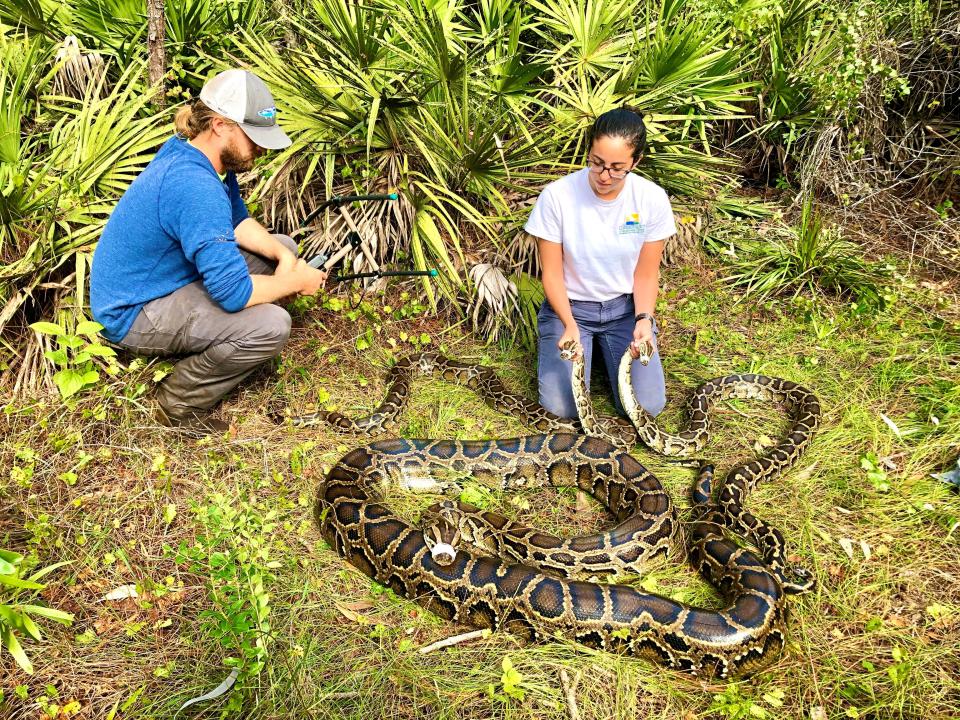Invasive pythons in Florida: Just how far can these snakes slither up north?

In the past three decades, invasive Burmese pythons have spread like the Florida Everglades. Taking out hundreds of native species and repopulating at lightning speed, pythons have dominated the region and have required statewide hunts to control the population.
However, is it possible for the large snakes to slither out of the swamps of South Florida toward the top of the state, possibly even to outside states, and dominate other areas?
Here's what we know from experts:
Are pythons heading up north?
In a recent study on Burmese pythons in Florida, scientists reveal that the snakes are now as far north as Lake Okeechobee, though most prefer to stay within south Florida, below Palm Beach County.
According to experts, there will be an increase in observed pythons in urban areas over the next five to 10 years. However, residents should not be alarmed, since most snakes will remain in natural areas.
What is a python's typical range?
Burmese pythons are currently considered established from just south of Lake Okeechobee to Key Largo and from western Broward County west to Collier County.
Per the Florida Fish & Wildlife Conservation Commission, officials said they are currently trying to learn more about Burmese pythons removed from the Charlotte County area, as the source of these animals is not known and there is not enough evidence to support that these pythons are connected to the established population in south Florida.
Any pythons found outside of those areas are likely escaped or released captive animals.
Growing appetite: How many wild critters does it take to grow a 13-foot python?
Research into these invasive snakes: Deadly Burmese pythons: Summer means it's time for biologists to crank out necropsies
Could pythons tolerate the colder weather up north?
Colder weather does limit the range of the Burmese python.
In their native habitat of India, lower China, the Malay Peninsula, and some islands of the East Indies, they need to see a tropical and warm temperate climate. Burmese pythons experience temperatures of around 88 degrees in the sun, similar to the climate seen in South Florida.
While the large snake might be able to withstand frigid temperatures longer due to its large size, the cold would still take a disastrous toll since they depend on the outside temperature to regulate its own body temperature.
What is the furthest north a python has been located?
On Nov. 9, 2012, a Burmese python was removed on the outskirts of the state, just outside of the Okefenokee National Wildlife Refuge.
What is a python's habitat?
The large snakes typically live in rainforests near streams, although they have been known to survive in a variety of habitats, such as grasslands, swamps and rocky foothills.
In Florida, the FWC notes that Burmese pythons are semi-aquatic and are often found near or in water.
How did pythons come to Florida?
According to past reports, Burmese pythons were introduced to the Sunshine State in the 1970s and 1980s when they were imported to be sold as exotic pets. However, some owners were unable to handle the giant snakes and find them new homes and ended up releasing them illegally into the wild.
Second-heaviest ever recorded: Python hunter shares dramatic details about capturing 198-pound snake, calling it a 'battle'
What should I do if I see a python?
Per the FWC, they recommend residents report Burmese pythons to the FWC immediately by:
Take a photo
Note your location
Report your sighting by calling the Exotic Species Hotline at 888-Ive-Got1 (888-483-4681), using the free IveGot1 mobile app, or online at IveGot1.org.
For those with a Burmese python they no longer wish to care for:
The Exotic Pet Amnesty Program allows those to surrender them with no questions asked and without penalties, regardless of whether those pets are kept legally or illegally. The program aims to reduce the number of non-native species being released into the wild by pet owners and fosters responsible pet ownership.
This article originally appeared on Fort Myers News-Press: Burmese pythons stick to South Florida but can they slither up North?

 money
money 